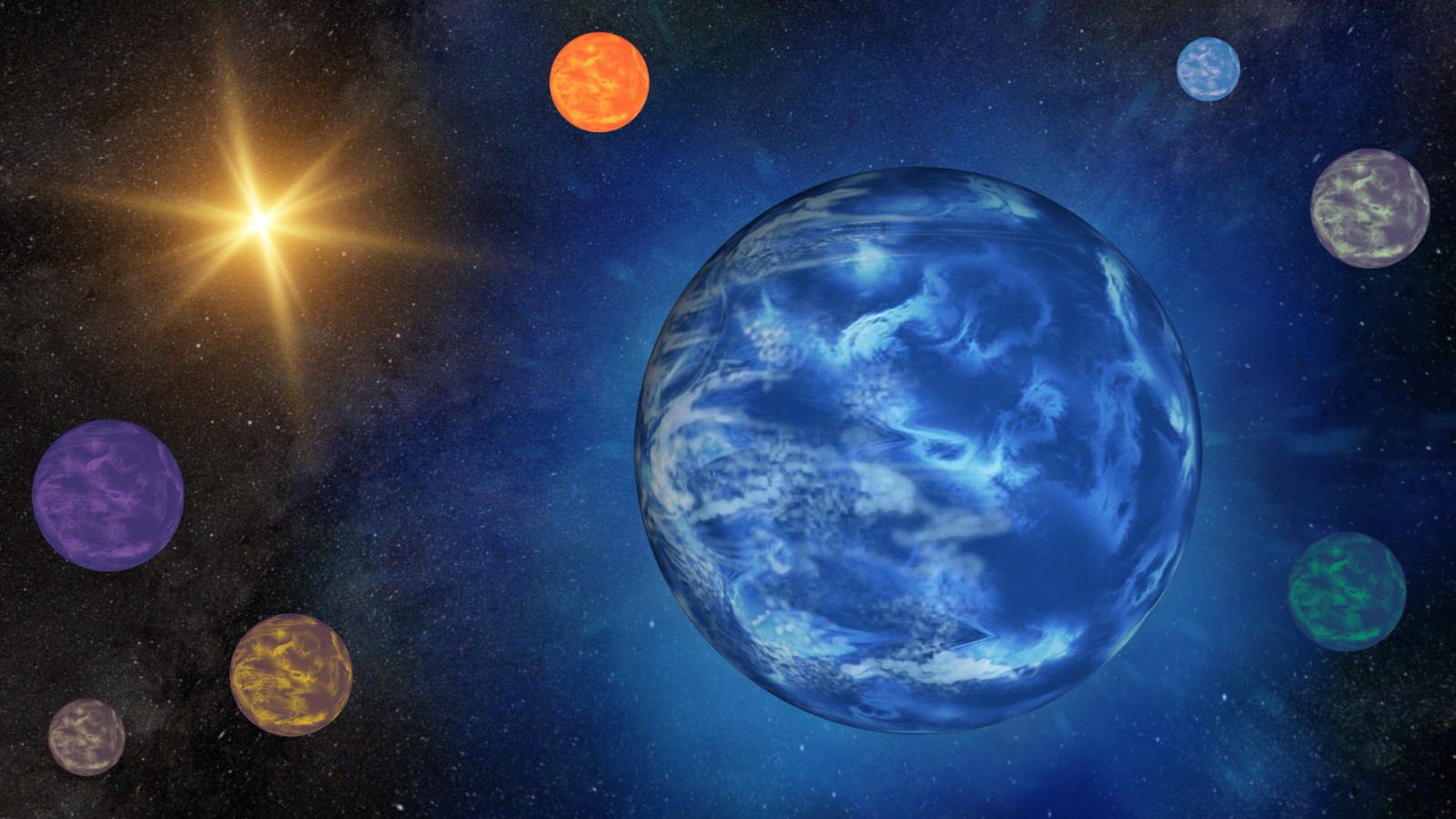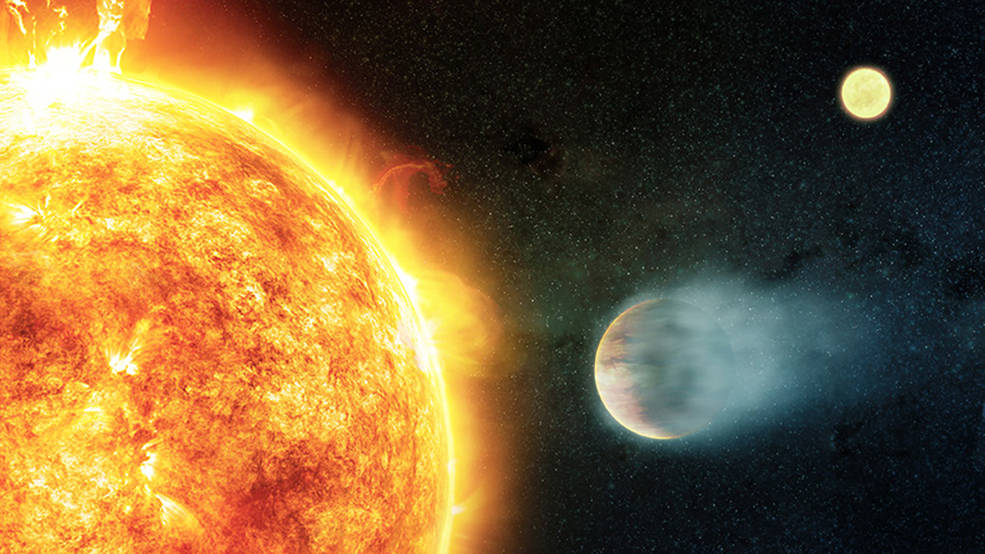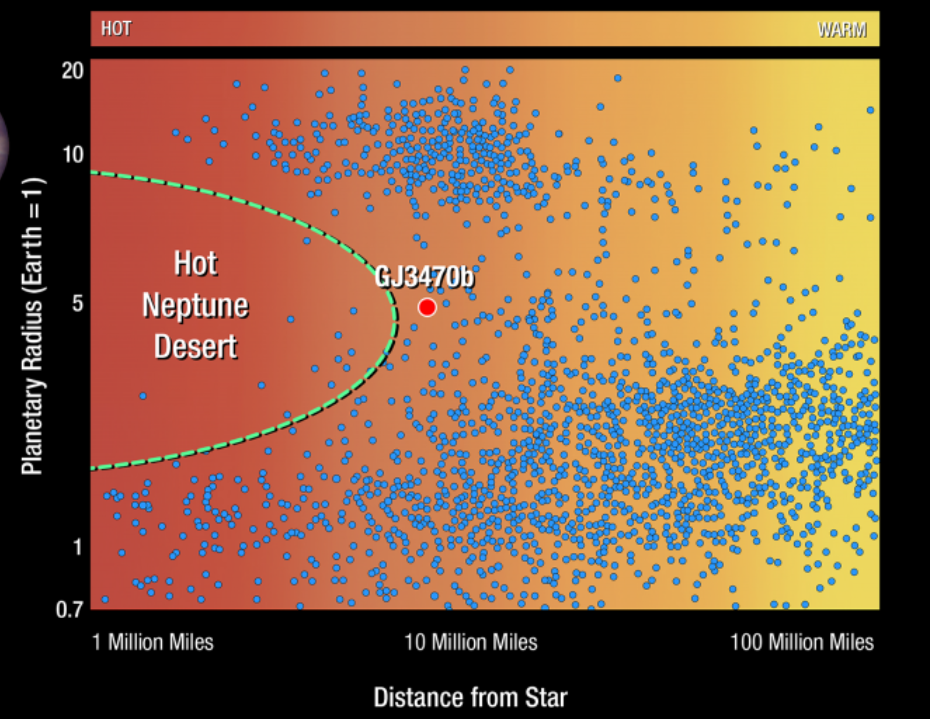Exoplanets may be hiding behind the 'Neptunian ridge'
"We found an overdensity of planets in this region, indicating a sharp transition between the barren Neptunian Desert and the more populated Neptunian Savanna."

Astronomers have discovered a new feature in the distribution of planets beyond the solar system, and this finding could help us understand the dynamics that determine the formation of exoplanets close to their stars.
The discovery — made by a team of scientists from the University of Geneva, the National Centers of Competence in Research (NCCR) Planets group, and the Centro de Astrobiología (CAB) — has been termed the "Neptunian ridge." The Neptunian ridge is a feature in the distribution of Neptune-sized exoplanets that sits between the called the "Neptunian desert," where there's an absence of Neptunian planets close to their star, also known as "hot-Neptunes," and the "Neptunian savanna," where there's an abundance of these worlds existing further out from their star.
The Neptunian desert has long been a puzzling feature to astronomers and planetary scientists, pointing to strange quirks in the evolution of planetary systems.
"We found an overdensity of planets in this region, indicating a sharp transition between the barren Neptunian desert and the more populated Neptunian savanna," Vincent Bourrier, Assistant Professor at the Astronomy Department of the UNIGE Faculty of Science and co-author of the study, said in a statement.
This newly identified ridge marks a critical zone where planets have managed to migrate inward while resisting intense radiation near their stars.
Related: Why are there so few 'hot Neptune' exoplanets?
The desert, the ridge and the savanna
To understand where the concept of the Neptunian desert comes from, it is worth considering how scientists sometimes categorize planets beyond the solar system. Since the discovery of the first extrasolar planet in the mid-1990s, scientists have uncovered over 6,000 planets beyond the solar system, with thousands more awaiting confirmation.
Get the Space.com Newsletter
Breaking space news, the latest updates on rocket launches, skywatching events and more!
Exoplanets can be of a vast array of sizes and masses, and can exist at different distances from their stars. They're usually compared to worlds within the solar system so scientists can understand some of their characteristics. So, "super-Jupiters" are planets more massive than Jupiter, super-Earths are more massive than Earth, and sub-Neptunes are planets smaller than Neptune.
The prefix "hot" describes a planet close enough to its star to complete an orbit in mere days or even hours.
Referring to a planet as "Neptune" in this respect doesn't indicate it is an ice giant, however, like our own Neptune. Likewise, super-Earths don't necessarily have to be terrestrial planets — they could be small gas planets. "Super-Jupiters" and "hot-Jupiters" are more likely to be gas giants like Jupiter, though, because of their vast size.

When scientists began to plot exoplanets based on things like their widths and the time they take to orbit their stars, many curious and fascinating patterns of planetary distribution emerged. One was the lack of Neptune-size worlds orbiting close to their stars: hot-Neptunes.
Scientists theorize this absence exists because close to stars, harsh radiation strips away the atmospheres of planets, thus "shrinking" them. This process is called photoevaporation.
Furthermore, beyond the barren figurative landscape of the Neptunian desert lies a region where Neptune-size worlds are found in abundance. That's the Neptunian savanna. Here, at greater distances from their stars, the worlds can hang on to their atmospheres and retain their size. Neptunian planets lurking in the Neptunian savanna are believed to migrate from their more distant locations away from their stars to the Neptunian desert, where they get closer to those stars and are quickly robbed of their atmospheres.
To understand how the Neptunian desert and savanna evolved, Bourrier and colleagues used data from NASA's Kepler space telescope. Defining precise regions of the "Neptunian landscape," they found a distinct region between the desert and the savanna, representing an orbital period of 3.2 to 5.7 Earth days. They dubbed this the "Neptunian ridge," finding that it reveals some of the intricate processes of Neptunian planet migration.

"The Neptunian ridge stands tall above the desert and savanna," Bourrier said. "It provides us with a key to understanding the physical mechanisms shaping the desert."
The fact that this ridge exists suggests that some Neptune-size planets are brought to this region by a type of movement called "high-eccentricity migration." This happens later in a planet's life, and it allows a world to survive the erosion of its atmosphere via radiation blasting from its star.
These migration processes and the photoevaporation of atmospheres are likely what shape the Neptunian desert, ridge and savanna observed in the Neptunian landscape.
The team will now turn to the Very Large Telescope (VLT) and its ESPRESSO (Echelle Spectrograph for Rocky Exoplanets and Stable Spectroscopic Observations) instrument to learn more about the Neptunian desert, savanna, and ridge.
This should allow the researchers to survey the orientation of a sample of rare hot-Neptunes. Knowing the orientation of a planet is important because it is a factor in understanding any exoplanet migration process, meaning it's a crucial piece of missing information about the evolution of close-in planets and why they don't tend to be Neptune-size.
"The Neptunian ridge is just the beginning," research first author Amadeo Castro-González, a Ph.D. student at the Center for Astrobiology in Madrid, said in the statement. "With upcoming results from this observational program, we'll be able to test our hypotheses about the origins and evolution of these intriguing worlds, providing a more comprehensive view of the close-in Neptunian landscape."
The team's research was published on Tuesday (Sept. 17) in the journal Astronomy & Astrophysics.
Join our Space Forums to keep talking space on the latest missions, night sky and more! And if you have a news tip, correction or comment, let us know at: community@space.com.

Robert Lea is a science journalist in the U.K. whose articles have been published in Physics World, New Scientist, Astronomy Magazine, All About Space, Newsweek and ZME Science. He also writes about science communication for Elsevier and the European Journal of Physics. Rob holds a bachelor of science degree in physics and astronomy from the U.K.’s Open University. Follow him on Twitter @sciencef1rst.
-
rod "To understand how the Neptunian desert and savanna evolved, Bourrier and colleagues used data from NASA's Kepler space telescope. Defining precise regions of the "Neptunian landscape," they found a distinct region between the desert and the savanna, representing an orbital period of 3.2 to 5.7 Earth days. They dubbed this the "Neptunian ridge," finding that it reveals some of the intricate processes of Neptunian planet migration."Reply
This is interesting orbital period area using the exoplanet sites. https://exoplanet.eu/home/
At the exoplanet.eu site I found 947 listed in this orbit period range. Masses run 0.2606 earth up to 60.86 Jupiter masses so some very large exoplanets in this orbit range.
https://exoplanetarchive.ipac.caltech.edu/index.html, using this site I found 916 exoplanets. Masses run 0.365 earth masses up to 22.1 Jupiter masses. Plenty to study here and sort out :) -
billslugg I can't discern where the ridge is. It's not labelled on the picture. Are they talking about the blob on top of the image?Reply -
Helio It’s hard to see it without an x-axis using periods. It’s hard to imagine the ridge even exists using that graph.Reply -
Torbjorn Larsson The paper suggests the high-eccentricity tidal migration for the ridge based on earlier orbit data (a surplus of elliptical orbits) but also based on comparing their 3-5 days ridge orbital period range with the overlap with the earlier found warm Jupiter ridge pileup.Reply
Comfusingly, the article is mixing planetary classifications. The paper claims that transiting planets, where radius can be estimated, are typically classified in three groups:
small planets (also known as sub-Neptune planets; R_p
It is more detailed classifications which uses "super-Earths" to try to discern between terrestrial planets and ice giants such as Neptune.
< 4 R_⊕), gas giants (also known as Jupiter-size planets; R_p
> 10 R_⊕), and intermediate planets (also known as Neptunian
planets; 4 R_⊕ < R_p < 10 R_⊕).
https://en.wikipedia.org/wiki/List_of_planet_types
It is an illustration external to the paper, which has much better graphs. I doubt ESA was the source due to the "miles" units, it is typically NASA that tries to inform the US public.Helio said:It’s hard to see it without an x-axis using periods. It’s hard to imagine the ridge even exists using that graph.
Fig. 2. Distribution of Neptunian planets across the orbital period space, where three regimes are differentiated: a significant deficit of planets at periods ⪅3.2 days (i.e the Neptunian desert), a moderately populated region at periods ⪆5.7 days (i.e. the Neptunian savanna), and an overdensity of planets between these regimes (i.e. the Neptunian ridge). The histogram error bars were computed as the square root of the quadratic sum of the weights.
Fig. A.1 Occurrence of Jupiter-size planets (Rp > 10 R⊕) across the orbital period space. The histogram error bars were computed as the square root of the quadratic sum of the weights. -
Helio That's impressive. ThanksTorbjorn.Reply
The very short orbital periods, especially for hot Jupiters, is a surprise.
I thought I'd try my hand with separating them by stellar class.
It is curious to see the similar patterns.









